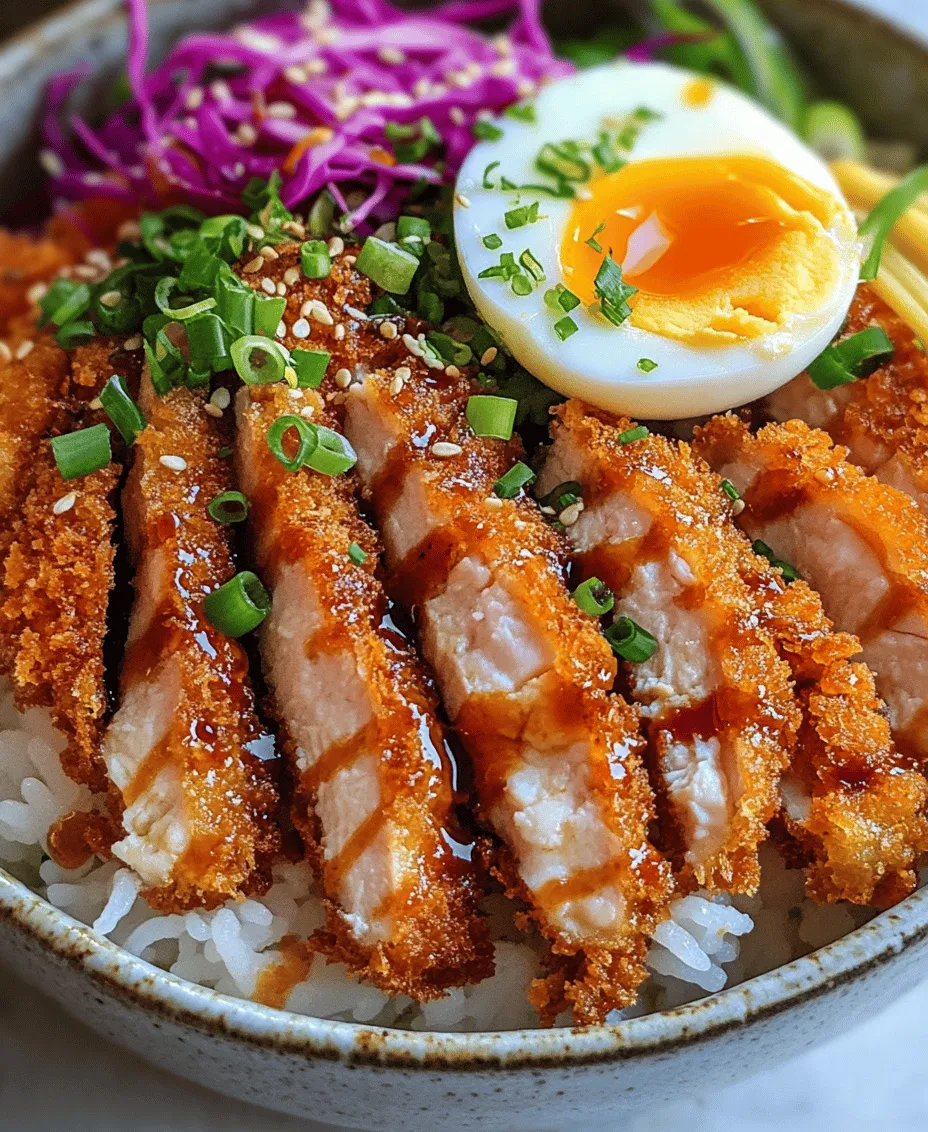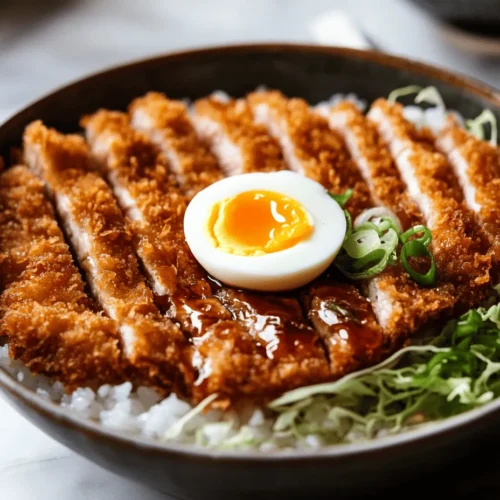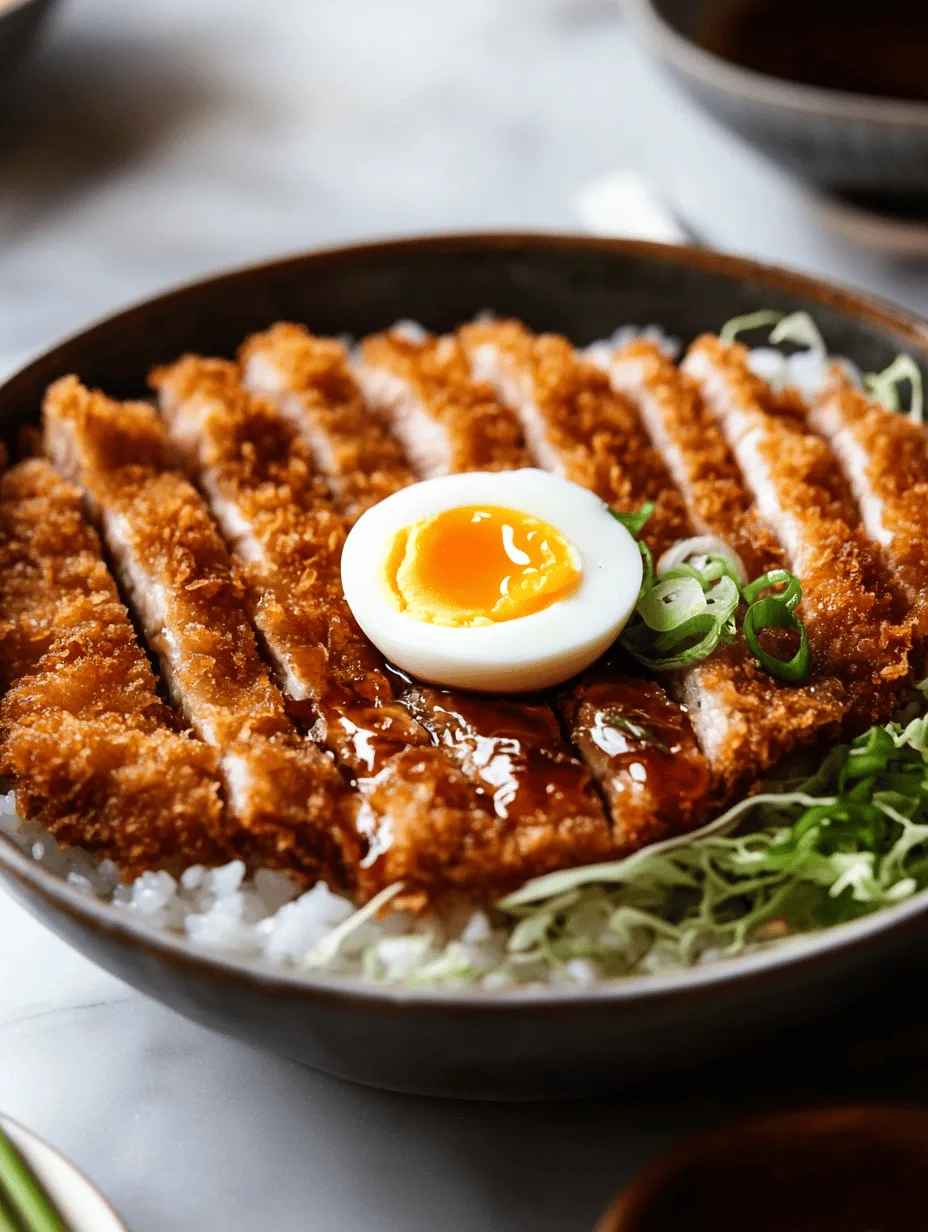Introduction
Katsu, a beloved dish in Japanese cuisine, has captured the hearts of food enthusiasts around the globe. This comforting meal, typically featuring breaded and fried meat, is synonymous with warmth and satisfaction. Among its many variations, Crispy Katsu Bowls stand out as a perfect harmony of flavors and textures, making them an ideal choice for any meal. The star of this dish, however, is the homemade Tonkatsu sauce, which elevates the Katsu from a simple fried dish to a culinary delight that tantalizes the taste buds.
What makes Tonkatsu sauce so special? Unlike its store-bought counterparts, homemade Tonkatsu sauce allows for a personalized touch, blending sweet, tangy, and savory flavors into a rich condiment that complements the crispy Katsu beautifully. As we delve into this recipe, we’ll explore not only how to create the perfect Crispy Katsu Bowls but also how to craft a Tonkatsu sauce that can take your dish to the next level.
Understanding Katsu
What is Katsu?
At its core, Katsu refers to a Japanese dish primarily made up of breaded and deep-fried meat. The term “Katsu” is derived from the English word “cutlet,” which reflects its origins. Traditionally, Katsu is made with pork (known as Tonkatsu), but variations have emerged over the years, including chicken Katsu (Torikatsu) and even vegetarian options, such as eggplant or tofu Katsu. Each version has its own unique charm, but the common thread remains the delightful crunch of the breading, which is crucial to the overall experience.
The Origins of Katsu
Katsu has its roots in the late 19th century when Western culinary practices began to influence Japanese cooking. As the country opened up to foreign trade and ideas, the concept of breading and frying meat was adapted to fit local tastes, leading to the creation of Tonkatsu. Over time, this dish became a staple in Japanese households and restaurants, celebrated for its satisfying crunch and tender meat.
Types of Katsu
1. Tonkatsu: The most popular variety, made with pork loin or fillet, often served with shredded cabbage.
2. Torikatsu: Chicken Katsu, typically made from chicken breast, is lighter and often enjoyed by those who prefer poultry.
3. Katsudon: A rice bowl topped with Katsu and a savory egg mixture, making it a filling one-dish meal.
4. Vegetarian Katsu: Options like eggplant or zucchini can be breaded and fried to provide a delicious plant-based alternative.
The Breaded Technique
The secret to achieving the perfect Katsu lies in the breading technique. Traditionally, Katsu is coated in flour, dipped in beaten eggs, and finally covered in panko breadcrumbs. Panko, a Japanese-style breadcrumb, is coarser and lighter than regular breadcrumbs, resulting in a crunchier texture when fried. This method not only creates a crispy outer layer but also helps seal in the moisture of the meat, offering a succulent bite.
Exploring Tonkatsu Sauce
What is Tonkatsu Sauce?
Tonkatsu sauce is a thick, savory-sweet condiment that serves as the perfect accompaniment to Katsu dishes. It adds depth and complexity, balancing the richness of the fried meat with its tangy profile. The sauce is usually dark brown in color and has a texture similar to ketchup, but its flavor is distinctly different, offering a subtle umami kick.
The Flavor Profile of Tonkatsu Sauce
The unique flavor of Tonkatsu sauce comes from a blend of ingredients that create a symphony of taste:
– Sweetness: This is usually achieved through the addition of sugar or sweeteners, balancing the savory notes.
– Tanginess: Vinegar and Worcestershire sauce contribute to the tangy aspect, brightening the overall flavor.
– Umami: Ingredients like soy sauce and sometimes even anchovies can enhance the umami element, making the sauce rich and satisfying.
Key Ingredients in Tonkatsu Sauce
1. Ketchup: Provides sweetness and a base for the sauce.
2. Worcestershire Sauce: Adds depth with its complex flavor profile, including tanginess and a hint of spice.
3. Soy Sauce: Introduces umami and saltiness, enhancing the overall taste.
4. Sugar: Balances the acidity and enhances the sweetness.
5. Dijon Mustard: Sometimes included for an extra kick, adding another layer of flavor.
Why Make Tonkatsu Sauce at Home?
While you can easily find Tonkatsu sauce in stores, making it at home offers several advantages. Firstly, you have full control over the ingredients, allowing you to adjust the flavors to your liking. Secondly, homemade sauce tends to be fresher and free from preservatives, ensuring a more authentic taste. Lastly, it’s a quick and straightforward process that can be completed in just a few minutes, making it a rewarding addition to your Katsu bowls.
Ingredients Overview
To create the perfect Crispy Katsu Bowls with Homemade Tonkatsu Sauce, it’s essential to gather high-quality ingredients. Below is a categorized list of what you’ll need for this recipe:
For the Katsu
– Protein: Choose your preferred option—pork loin, chicken breast, or a vegetarian alternative like eggplant.
– Flour: All-purpose flour for dusting.
– Eggs: Fresh eggs for the batter.
– Panko Breadcrumbs: The star of the breading process for that crunchy texture.
– Salt and Pepper: Essential for seasoning the meat.
For the Tonkatsu Sauce
– Ketchup: A basic ingredient that forms the base of the sauce.
– Worcestershire Sauce: Adds complexity.
– Soy Sauce: Enhances umami flavors.
– Sugar: Balances the tanginess.
– Dijon Mustard: Optional, for an extra flavor boost.
Ingredient Substitutions
If you have dietary restrictions or preferences, there are several substitutions you can make:
– Gluten-Free: Use gluten-free flour and panko breadcrumbs to create a gluten-free version of Katsu.
– Vegetarian/Vegan: Opt for eggplant, tofu, or seitan in place of meat. Ensure the Tonkatsu sauce ingredients are vegan-friendly, omitting any animal-derived products.
Importance of Quality Ingredients
When it comes to Katsu, the quality of your ingredients significantly impacts the final dish. Fresh, high-quality meat will yield a juicier result, while premium panko will ensure the best crunch. Always opt for the freshest produce and sauces to create a meal that is not only delicious but also memorable.
Step-by-Step Preparation of Tonkatsu Sauce
Now that you have a clear understanding of Katsu and Tonkatsu sauce, it’s time to prepare the sauce that will bring your Crispy Katsu Bowls to life. Follow these simple steps to create a delicious homemade Tonkatsu sauce:
1. Gather Your Ingredients: Ensure you have all the necessary ingredients measured and ready to go. This helps streamline the process and ensures you won’t miss anything.
2. Mix the Base: In a medium bowl, combine 1/2 cup of ketchup with 1/4 cup of Worcestershire sauce. Stir until well blended.
3. Add Soy Sauce: Pour in 2 tablespoons of soy sauce. This will add depth to the sauce.
4. Sweeten It Up: Add 2 tablespoons of sugar, adjusting to taste. Stir until the sugar is fully dissolved.
5. Incorporate Mustard: If using, add 1 tablespoon of Dijon mustard to the mixture. This will enhance the sauce with a slight kick.
6. Taste and Adjust: The beauty of homemade sauces is that you can tailor them to your preference. Taste the sauce and adjust any of the ingredients as necessary—more sugar for sweetness, extra Worcestershire for tang, or additional soy sauce for saltiness.
7. Store or Serve: Once you have achieved the desired flavor profile, transfer the sauce to an airtight container. It can be stored in the refrigerator for up to two weeks, making it a convenient option for multiple meals.
This homemade Tonkatsu sauce will not only elevate your Crispy Katsu Bowls but can also be used for other dishes, such as grilled meats or as a dipping sauce for fried snacks.
As we continue deeper into the recipe, we will explore the preparation of the Katsu itself, combining all these elements into a truly delightful meal. Stay tuned for more steps on how to bring this iconic dish to your table!

Tips for Adjusting Sweetness and Tanginess to Personal Preference
Creating your own homemade Tonkatsu sauce allows for a personalized flavor profile that can elevate your Katsu Bowls. The basic sauce typically has a perfect balance of sweetness and tanginess, but you can easily adjust these elements to suit your taste. Here are some tips:
1. Sweetness: If you prefer a sweeter sauce, consider adding more mirin or sugar. Start by adding one teaspoon at a time, mixing well after each addition until you reach your desired level. Honey or maple syrup can also be used for a different type of sweetness that complements the sauce’s flavor.
2. Tanginess: For a tangier sauce, increase the amount of rice vinegar or Worcestershire sauce. Again, add in small increments, tasting as you go to ensure that the tanginess does not overpower the other flavors.
3. Umami Boost: If you’re looking to enhance the umami flavor, adding a splash of soy sauce can deepen the overall taste profile. This addition pairs wonderfully with the savory notes of the pork.
Preparing the Tonkatsu
Making a perfect Tonkatsu starts with the pork chop. Here’s how to ensure your meat is flavorful and the coating adheres perfectly.
1. Choosing the Right Cut: For the best results, select boneless pork loin chops, ideally about 1-inch thick. This thickness ensures a juicy interior while allowing for a crisp exterior after frying.
2. Proper Seasoning: Begin by seasoning both sides of the pork chops generously with salt and pepper. Let them rest for about 15-30 minutes to allow the seasoning to penetrate the meat.
3. Breading the Pork:
– Dredging Process: Set up a dredging station with three shallow dishes. The first should contain all-purpose flour, the second should have beaten eggs, and the third should be filled with panko breadcrumbs.
– Coating Technique: First, coat the seasoned pork chop in flour, shaking off any excess. Then dip it into the beaten eggs, ensuring a thorough coating. Finally, press it firmly into the panko breadcrumbs, making sure the crumbs adhere well. For optimal adhesion, press the panko into the meat firmly and consider repeating the egg and panko step for an extra crunchy coating.
4. Frying the Pork:
– Oil Temperature: Use a heavy-bottomed skillet or deep frying pan and heat oil (vegetable or canola oil works best) to about 350°F (175°C). A thermometer can help ensure the oil is at the right temperature.
– Cooking Time: Carefully place the breaded pork into the hot oil. Fry for about 4-5 minutes on each side until golden brown and crispy. Use a slotted spoon to turn the pork, minimizing splatter and ensuring even cooking.
– Draining Excess Oil: Once cooked, remove the pork from the oil and place it on a paper towel-lined plate to absorb excess oil. This step is crucial for maintaining that crispy texture.
Creating the Katsu Bowl
Now that you have your perfectly fried Tonkatsu, it’s time to assemble the Katsu Bowl.
1. Assembling the Bowl:
– Start with a base of fluffy white rice, which acts as the foundation of your bowl. Use sushi rice for a more authentic touch, but any short-grain rice will work.
– Next, pile on a generous portion of finely shredded cabbage. This adds crunch and freshness to the dish, balancing the richness of the fried pork.
2. Layering the Tonkatsu: Slice the fried pork chops into strips and place them on top of the rice and cabbage. The juicy pork, combined with the crispy coating, creates a delightful texture contrast.
3. Customizing with Toppings:
– For added flavor and nutrition, consider adding soft-boiled eggs, which are a popular Japanese addition to Katsu Bowls. Simply boil the eggs for around 6-7 minutes, then plunge them into ice water before peeling.
– Additional vegetables like pickled ginger, sliced cucumbers, or grilled zucchini can enhance the bowl’s visual appeal and taste.
4. Presentation Tips: To elevate your Katsu Bowl, use a large, shallow bowl for serving. Arrange the ingredients in a visually appealing manner—consider placing the rice at the center, followed by the cabbage, and artfully layering the Tonkatsu on top. Drizzle the homemade Tonkatsu sauce over the pork, and garnish with sliced green onions or sesame seeds for a beautiful finish.
Serving Suggestions
Crispy Katsu Bowls are perfect for both family meals and entertaining guests.
1. Family Meals: Set up a Katsu Bowl station where each family member can customize their bowl. Offer toppings and sauces on the side, allowing everyone to create their perfect dish.
2. Entertaining Guests: Serve the Katsu Bowls as part of a Japanese-themed dinner. Pair them with appetizers like edamame, miso soup, or gyoza for a complete dining experience.
3. Beverage Pairings: Complement your Katsu Bowl with refreshing drinks. Consider serving iced green tea, Japanese beer, or even a light, fruity sake to enhance the meal.
Nutritional Information
When preparing Crispy Katsu Bowls, it’s essential to be mindful of the nutritional content:
1. Overview of Nutritional Content: A serving of Katsu Bowl typically contains around 600-800 calories, depending on the portion sizes and specific ingredients used. This includes protein from the pork, carbohydrates from the rice, and fiber from the cabbage.
2. Portion Control and Balanced Eating: While Katsu Bowls are delicious, moderation is key. Consider serving smaller portions or pairing them with a side salad to increase vegetable intake and balance the meal.
3. Healthy Alternatives: For a lighter version, you could try using chicken breast or tofu instead of pork and bake instead of frying. Additionally, brown rice or cauliflower rice are great substitutes for white rice if you’re looking for healthier options.
Conclusion
Making Crispy Katsu Bowls at home is not just about enjoying a meal; it’s about the joy of cooking and the satisfaction of sharing that experience with loved ones. With a perfectly fried Tonkatsu, tangy homemade Tonkatsu sauce, and a customizable bowl, you can bring a taste of Japan right to your table.
Don’t hesitate to experiment with variations of this recipe. Try different proteins, sauces, or toppings to make it your own. The beauty of homemade meals lies in the creativity and flavors you can explore. So gather your ingredients, invite your family or friends, and delight in the process of creating delicious Katsu Bowls that everyone will love. Enjoy the flavors, share the love, and indulge in the satisfaction of homemade cooking!



